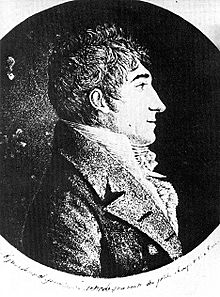Karl Ludwig Harding facts for kids
Quick facts for kids
Karl Ludwig Harding
|
|
|---|---|

Portrait by Quenedey
|
|
| Born | 29 September 1765 Lauenburg/Elbe, Duchy of Saxe-Lauenburg
|
| Died | 31 August 1834 (aged 68) Göttingen, Kingdom of Hanover
|
| Education | University of Göttingen |
| Known for | 3 Juno, astronomical discoveries |
| Awards | Fellow of the Royal Society Lalande Prize |
| 3 Juno | 1 September 1804 | MPC |
Karl Ludwig Harding (born September 29, 1765 – died August 31, 1834) was a German astronomer. He is famous for discovering Juno. Juno was the third asteroid ever found in the main-belt of our solar system. He found it in 1804.
Contents
Exploring the Cosmos: Karl Harding's Life
Early Life and Education
Karl Ludwig Harding was born in Lauenburg, a town in Germany. He went to the University of Göttingen from 1786 to 1789. There, he studied important subjects like theology, mathematics, and physics. These studies helped him prepare for his future work.
Becoming an Astronomer
In 1796, a keen astronomer named Johann Hieronymus Schröter hired Harding. Harding became a tutor for Schröter's son. Schröter had a great observatory in Lilienthal, near Bremen. Because of his skills, Harding soon became an observer and inspector at this observatory.
Discovering Juno
In 1800, Harding joined a special group of 24 astronomers. This group was called the "celestial police." Their main goal was to search for new planets in our solar system. In 1804, while working at Schröter's observatory, Harding made a big discovery. He found Juno, which was the third asteroid ever discovered.
Moving to Göttingen
The next year, in 1805, Harding left Lilienthal. He became a professor of astronomy at the University of Göttingen. From 1807, he worked alongside another famous scientist, Carl Friedrich Gauss, at the Göttingen Observatory. Harding continued his important work there until he passed away suddenly in 1834.
Other Discoveries
Besides Juno, Harding found many other interesting things in space. He discovered three comets, which are icy space objects. He also found several variable stars. These are stars whose brightness changes over time. Some of these include R Virginis and R Aquarii. Harding also found new nebulae. One of the most famous is NGC 7293, also known as the "Helix Nebula" or "the Eye of God."
Awards and Recognition
Honored for His Work
Karl Ludwig Harding received many honors for his contributions to astronomy. He became a member of important scientific groups. These included the Royal Academy of Sciences in Göttingen. He was also elected as a member of the Royal Society in London in 1806. Later, he joined the Royal Astronomical Society.
Special Prizes
In 1804, Harding was given the Lalande Prize. This was a special award for achievements in astronomy. The government also gave him the title "Hofrath," which means "Councillor of the court."
Named After Him
To remember his important work, two space objects were named in his honor. There is a crater on the Moon called Harding. Also, an asteroid was named 2003 Harding after him.
Notable Works
Harding wrote several important books and charts about stars.
- Atlas novus coelestis (1808–1823): This was a huge catalog that listed 120,000 stars. It was later updated.
- Kleine astronomische Ephemeriden (1830–35): He edited this work with Wiessen. It contained tables of positions of celestial objects.
- Berliner Akademische Sternkarten (1826, 1830): He contributed to this series of star charts.

